
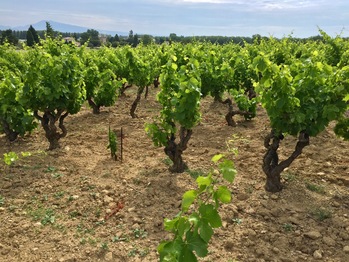 |
| Jean-Paul Autard carries on the tradition established by Paul Autard when he founded the domaine in the village of Courthézon in the 1970's. He took over very early, at 17 year old, after his father passed away. Autard has 26 hectares of vines, of which 12 are in Châteauneuf-du-Pape and 14 in Côtes-du-Rhône (located at the border of the Châteauneuf appellation in Courthézon.) The aging cellar is a massive, vaulted cave cut into sandstone rock, housing the domaine’s barriques. The Autards feel privileged to have inherited a domaine in which the plantations of different varieties are perfectly adapted to the soil types - ranging from galets roulés, pebble and clay, to sandy-clay. They aim to get the most out of each variety by vinifying separately and then blending judiciously. The grapes are destemmed and fermentation takes place in stainless steel tanks with indigenous yeasts. After the malolactic fermentation, the wines are transferred to barriques for aging, about one third of which are new for the regular cuvée of Châteauneuf and 100% new for La Côte Ronde and Juline. Since 2004, Jean-Paul has been working in his new state-of-the-art winery, which allows him greatly enhanced control over all phases of winemaking, and a concomitant increase in quality. His unique style, fusing elegance, balance and generously expressive Châteauneuf-du-Pape flavor, has won his wines an international following. Farming/vinification practices: sustainable farming. Jean-Paul aims to achieve a perfect balance between the soil and the vine. He does not need to green harvest because his vines are on average over 50 year old. The vines’ age, together with the limited use of only organic fertilizer, naturally ensures low yields and concentrated, balanced fruit. No pesticides or chemical anti-rot products or fertilizers are used. The health of the vineyard is ensured by meticulous work by hand, such as the removal in May and June of unessential shoots and leaves that would block the proper aeration of the vines. Jean-Paul is able to eliminate the possibility of problems such as rot and mildew by not allowing humidity to remain on the grapes and leaves. The wines are vegan. 2013 vintage notes: The cold and rainy winter of 2012-2013 continued well into the Spring of 2013. April was cool and rainy and there were only a few buds visible by mid-month. The cool weather continued into May. Flowering was late, in mid June, with significant coulure or aborted flowers. But temperatures gradually warmed and by mid-July the vineyards were in excellent health. The Syrah and Mourvèdre vines were in perfect condition. The only negative point was the diminished proportion of Grenache due to the prevalence of shot bunches - on the positive side, the Grenache grapes that did blossom ripened perfectly due to unimpeded exposure to light and air. July and August were warm and sunny with occasional Mistral and cool nights. The excellent weather continued into September. The grapes underwent veraison in early August, about one week later than in 2012 and two and three weeks later than in 2010 and 2011, respectively. The warm days and cool nights of late September brought the fruit to optimal maturity with balanced sugars and tannins. The parallel development of phenolic maturity provided complex aromas and flavors. |
| Domaine Paul Autard Website |
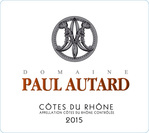 |
| Côtes-du-Rhône |
| 85% Grenache and 15% Syrah, from grapes grown in several parcels just outside the Châteauneuf-du-Pape appellation in Courthézon. The vines average 45 year old, with the oldest being 75 year old. The grapes are all handpicked and transported to the winery in small boxes so as not to damage the fruit. Autard sorts the harvest twice, and then de-stems and lightly crushes the fruit to spontaneously begin the fermentation process by releasing the juice. Maceration and fermentation take place in temperature-controlled stainless steel tanks over 25 days. Autard’s tanks are equipped with a pneumatic mechanism to carry out pigeage (or punching down of the cap) to ensure optimal and gentle extraction. In addition, two pumping over operations (remontages) are carried out daily for 10 days, to enhance extraction and aerate the wine, in order to obtain a plush texture. Each of the varieties are vinified separately, assembled in late January, and aged in stainless steel tanks until bottling in late February. Autard’s Côtes-du-Rhône is a smoky, complex wine, loaded with warm raspberry fruit, showing many of the best attributes of Châteauneuf-du-Pape. 14.5% alcohol. |
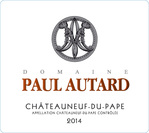 |
| Châteauneuf-du-Pape |
| 70% Grenache, 15% Syrah, 8% Mourvèdre and 7% Cinsault, from 9 hectares of vines in 12 parcels in the north-east sector of the appellation, Courthézon. The parcels are : Le Mourre de Gaud, Palinteau, L'Etang, Le Cristia, Valori. The vines average 50 to 95 year old. There are 3 soil types: limestone/clay with sand and galets roulés, dominantly sand, and stony limestone/clay with fossils. The grapes are hand-harvested, selected in the vineyard, and then carefully transported to the winery in small crates. There they are sorted twice on a vibrating sorting table, before and after destemming. The grapes are then given about 24 hours of cold maceration, to ensure the fermentation does not begin too quickly. They are then lightly crushed, and placed in temperature-controlled, stainless steel tanks. Fermentation begins slowly with only the native yeasts. Extraction is attained with a gentle pneumatic pigeage mechanism in the tanks. The cuvaison phase lasts 30 to 40 days. Autard punches down and pumps over the cap twice daily during the first 10 days of the active fermentation phase, and then several times during the vatting period. The young wines are then transferred to 225 liter barriques which are one-third each new; 2 to 4 years; and 6 to 8 years. The barrel aging period last about 18 months during which time the malolactic fermentation takes place. Autard assembles the 4 varieties about 19 months after the harvest, and bottles the wine in March. It is a balanced, elegant, deeply colored and vividly flavored Châteauneuf-du-Pape, due to the old vines’ naturally low yields. It brims with fresh and pure dark berry fruit and notes of black pepper and chocolate. 2900 cases produced. |
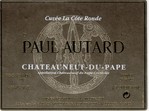 |
| Châteauneuf-du-Pape - "La Côte Ronde" |
| One of Autard’s top wines, La Côte Ronde comes from a parcel of vines that are between 75 and 90 year old. They are planted in stony, fossil-rich soil on a dome-shaped hill (hence the name “Côte Ronde”), in the Le Mourre de Gaud lieu-dit, on the plain between the village of Châteauneuf and Courthézon. The blend is 50% Grenache and 50% Syrah (from sandy soil). The Côte Ronde parcel is vinified separately and is aged 16 months in 100% new French oak barrels. It is an intensely concentrated, lush-textured wine with vivid dark fruit, spice, chocolate and oak flavors. Autard only makes this cuvée in top years. It has consistently received 90+ scores from Parker since its inception. |
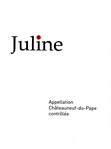 |
| Châteauneuf-du-Pape - "Juline" |
| The 2006 vintage marked the debut release of Autard’s highly personal and original Châteauneuf-du-Pape "Juline". Named for his two children, Julien and Pauline, the wine is a blend of 50% Syrah from 55 year old vines on a parcel with sandy soil and 50% Grenache from 80 year old vines from a parcel with "galets roulés" (the famed round stones) and sand. Fermentation, vinification and maturation entirely in new, medium toast, Seguin-Moreau barrels (each made from oak of diverse origins) with one side removed. The fruit is placed directly in the casks and given a 30 day maceration period with daily pigeage by hand. The varieties are vinified separately. At the end of the maceration period, the wine is transferred to a tank, the solids are pressed, and the juice then returned to the barrels within two days. At this point, the barrel maker comes to the winery to replace the sides of the barrels, and the wine then begins its 16 month maturation period in these same barrels. Four days before bottling, the Grenache and Syrah are assembled in a tank, fined, and bottled without filtration. |
| Copyright © 2002-2017 VOS Selections, Inc. |